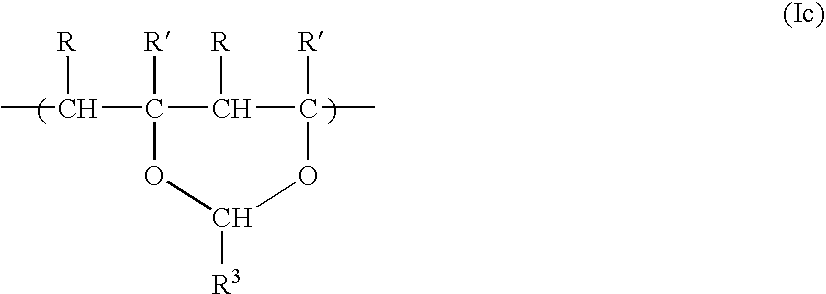Method of imaging and developing positive-working imageable elements
- Summary
- Abstract
- Description
- Claims
- Application Information
AI Technical Summary
Benefits of technology
Problems solved by technology
Method used
Image
Examples
invention example 1
[0164]An imageable element of the present invention was prepared in the following manner using the following positive-working infrared radiation-sensitive composition formulation:
Polymer A0.9020 gLB 9900 (49% in PM)0.1220 gS 0094 IR Dye0.0300 gCrystal Violet0.0240 gSudan Black B0.0240 gDMABA0.1560 gPolyfox ® PF 652 (10% in PM)0.0360 gMEK 4.83 gPM 8.88 g
[0165]The formulation was filtered and applied to an electrochemically roughened and anodized aluminum substrate that had been subjected to a treatment with an aqueous solution of sodium phosphate / sodium fluoride by means of common methods and the resulting imageable layer coating was dried for 30 seconds at 100° C. in Glunz&Jensen “Unigraph Quartz” oven. The dry coverage of the imageable layer was about 1.5 g / m2. The single imageable layer was the outermost layer of the imageable element. The imageable element was conditioned with interleave paper for two days at 60° C. and 25% RH.
[0166]The resulting imageable element was exposed on ...
invention example 2
[0167]Imageable elements were prepared, imaged, and processed using the same general procedure described above for Invention Example 1, this time processing the imaged element for 60 seconds and using the following infrared radiation-sensitive composition formulation:
Polymer A0.7460 gLB 9900 (49% in PM)0.0490 gS0094 IR Dye0.0240 gCrystal Violet0.0190 gSudan Black B0.0190 gDMABA0.1250 gPolyfox ® PF 652 (10% in PM)0.0290 gMEK 3.86 gPM 7.13 g
The results obtained for Invention Example 2 are shown below in TABLE I.
invention example 3
[0168]An imageable element was prepared, imaged, and processed using the same general procedure described above for the Invention Example 1, but this time the imaged and processed element was dried at 60° C. for 1 minute. Twenty hours later, the lithographic printing plate was mounted on a Heidelberg GTO-52 printing press, washed with water, and used to make 150,000 high quality impressions (200 lpi). TABLE I
TABLE ISensitivityLinearityCyan Density(Clearing Point)Point (LP)Loss (CDL)Imageable Element(mJ / cm2)(mJ / cm2)(%)Invention Example 11001509.7(M-1 at 26° C. / 80 sec)Invention Example 21101508.0(M-1 at 26° C. / 60 sec)
[0169]The results in TABLE I show that a positive-working, infrared radiation-sensitive imageable element prepared using a formulation containing Polymer A can be processed (developed) revealing the latent image using the carbonate-containing M-1 single processing solution according to the present invention. The results of Invention Example 3 show that the printing surfac...
PUM
 Login to View More
Login to View More Abstract
Description
Claims
Application Information
 Login to View More
Login to View More - R&D
- Intellectual Property
- Life Sciences
- Materials
- Tech Scout
- Unparalleled Data Quality
- Higher Quality Content
- 60% Fewer Hallucinations
Browse by: Latest US Patents, China's latest patents, Technical Efficacy Thesaurus, Application Domain, Technology Topic, Popular Technical Reports.
© 2025 PatSnap. All rights reserved.Legal|Privacy policy|Modern Slavery Act Transparency Statement|Sitemap|About US| Contact US: help@patsnap.com



